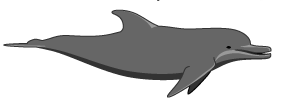Biomechanics at the BIOlympics
Here at Whyville's BIOlympics, you will train and manage your team of animal athletes to compete against other animals in running, swimming, and biting events.
What will determine whether your athletes will capture gold? Biomechanics! What is biomechanics, you ask? Read on...
Overview of Biomechanics
Let's start by looking at the parts of that word. "Bio" comes from biology, the study of life. Mechanics, an area of physics, is the study of forces and motion.
Biomechanics is where biology and physics meet. People who study biomechanics use the principles of motion and forces to understand how animals and other living things move and survive.
In the BIOlympics Training Rooms, you can prepare for your team's competitive events by exploring and testing how animals can run, bite, and swim under different conditions.
To learn more about biomechanics, check out videos and activities on the website for the Field Museum's exhibition
"The Machine Inside: Biomechanics".
Biomechanics of Jaws
Jaws are pretty important for the survival of any animal. How else would they eat? Some animals need strong jaws that can bite through bone. Others need jaws that can bite fast to catch dodgy prey.
To understand if animals are hard or fast biters, scientists apply principles of levers. Levers include a fulcrum (pivot point), the load (what you want to bite) and the effort force (the force the
 jaw muscle applies). In some cases, levers change a small force into a large force. In other cases they turn a slow motion into a fast motion. They can't do both though. That'd be too perfect.
You can explore this trade-off between speed and strength in the Bite Training Room.
jaw muscle applies). In some cases, levers change a small force into a large force. In other cases they turn a slow motion into a fast motion. They can't do both though. That'd be too perfect.
You can explore this trade-off between speed and strength in the Bite Training Room.
Biomechanics of Running
There are a number of things that can affect how fast an animal runs. First, let's look at speed. Speed is simply distance over time. The speed of an animal is how far the animal travels with each
stride or step (distance), multiplied by how many strides it makes per second (per time). The farther the animal travels with each stride and the more strides it takes per second, the faster the animal.
 Of course, there's more: Muscle type also affects running. Some muscle types allow an animal to run extra fast, but these muscles also tire very quickly. So, these animals are better at sprinting.
Other muscle types allow animals to keep a slow but steady pace, so they are better at long distance running. You can explore all this in the Run Training Room.
Of course, there's more: Muscle type also affects running. Some muscle types allow an animal to run extra fast, but these muscles also tire very quickly. So, these animals are better at sprinting.
Other muscle types allow animals to keep a slow but steady pace, so they are better at long distance running. You can explore all this in the Run Training Room.
Biomechanics of Swimming
When we walk or run, we are pushing against the ground and transferring energy so we can move forward. Similarly, when we swim, we push against water in order to move forward. The shape of an aquatic
animal's fins will affect how well it can "push against" the water to move forward and how well it can continue gliding once it's gotten going. Some animals swim by pushing their tail against water
 while others use their fins to push against water to move forward. The shape of those tails and fins help determine how fast and well they push, how easily they can turn, and how long they can continue
gliding after a push. Visit the Swim Training Room to explore how shape can affect the way animals swim!
while others use their fins to push against water to move forward. The shape of those tails and fins help determine how fast and well they push, how easily they can turn, and how long they can continue
gliding after a push. Visit the Swim Training Room to explore how shape can affect the way animals swim!